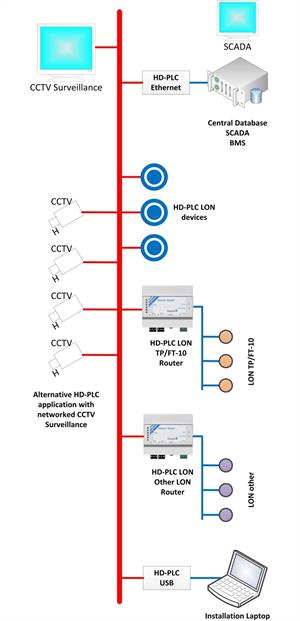The Smart City Blog
Smart Building Network Based on HD-PLC
HD-PLC is the new standard for high-speed wireline networks. Based on the IEEE 1901 and ITU-T G.9905 international standards, HD-PLC offers megabit speeds over up to several kilometers of wiring (AC/DC powerlines, twisted-pair, coax, phone lines, etc.). The combination of high-speed, long-distance communication, and physical media flexibility makes it well suited for a wide variety of building automation systems (BAS).
In this article, we review an example smart building network built using HD-PLC. This network can integrate multiple systems found in modern smart buildings, including IP cameras, environmental sensors, security systems, building comfort systems, lighting, and more. Thanks to HD-PLC’s multi-hop technology, any node can act as a repeater to extend network range and robustness. This network can scale to support up to 1024, distributed across the building, using any wiring available.
Support High-Bandwidth Applications
Originally developed for multimedia networks in residential applications, HD-PLC supports blazing-fast megabit data rates (up to 240Mbps, PHY) over powerlines and other physical media. It has since been enhanced with industrial-grade robustness mechanisms to ensure reliable operation in smart building systems. These characteristics make it well-suited for IP camera networks.
The left side of the network diagram shows a standard CCTV surveillance application using HD-PLC CCTV-IP cameras. HD-PLC uses IP-based communications (IPv4 or IPv6 multicasting) to encapsulate packets as UDP messages. This means that IP cameras are able to draw power from the main supply and also use it to transfer high-definition video to the central surveillance station. This simplifies the deployment of IP-based CCTV systems, since you don’t need to install new wiring to support the bandwidth required by these cameras.
Develop Faster, Smarter LON Systems
In 2017, LonMark adopted HD-PLC as the new standard for high-speed wireline networks. Compared to the previous LonWorks solution that was limited to 78kbps over twisted-pair and just 5.4kbps over power line, HD-PLC brings a significant speed advantage to wired control networks. Now system designers can get the cost savings of using existing wiring infrastructure along with the bandwidth they need to build smarter systems.
The right side of the network diagram illustrates a typical LON building automation scenario. The backbone for this network is provided by the main power line, to which a variety of standard LON systems are attached. HD-PLC is fully compatible with LON, and all of the devices are able to behave exactly as they would in any other LON system.
At the top of the diagram is the LON network server (LNS) with SCADA and BMS clients. LonMaker for Windows is another client that one might use in this network to manage installation and maintenance software. These clients are easily connected to the powerline backbone using an HD-PLC/Ethernet adapter.
Connected below the LNS database are HD-PLC LON nodes. These can be connected directly to the powerline, as in Section A. Alternately, they can be connected to an Easylon® HD-PLC router from Gesytec (Sections B and C), which enables seamless translation from HD-PLC LON to other LonWorks channels like the familiar TP/FT-10 physical layer.
In this smart building network example, HD-PLC replaces the existing LON/IP backbones, which require costly Ethernet cabling. By using the same wiring infrastructure used for power distribution, HD-PLC greatly reduces installation cost. It also improves system reliability, since the backbone is now independent of other IT equipment like Ethernet switches.
Simplify Network Deployment and Management
System integrators appreciate the simplicity of HD-PLC. Its built-in multi-hop technology takes the guesswork out of network planning and design by providing the plug-and-play simplicity of a mesh network. With this technology, the nodes in the network dynamically calculate route cost and select the best route based on link quality. This eliminates bottlenecks and improves robustness, since the network will automatically reroute traffic if any given node fails.
MegaChips HD-PLC solution comes with Network Manager software that makes it easy to configure, monitor, and manage complex networks. The bottom of the network diagram shows how the installation laptop can be connected using an HD-PLC/USB adapter to easily manage the network. Simply plug the HD-PLC/USB adapter into any power outlet, and you’re instantly able to connect to the building automation network.
Getting Started with HD-PLC
It’s easy to upgrade to megabit data rates; build larger, more robust IIoT networks; and meet new cybersecurity demands with MegaChips’ HD-PLC SoC with Multi-hop. Combining a state-of-the-art analog front-end (AFE) with baseband, physical (PHY), and media access control (MAC) layers into a single compact package, the MegaChips solution enables you to reliably deliver high-speed, bidirectional, IP-based communications over any wiring.
MegaChips provides all the design resources and tools you need to quickly develop and deploy products with HD-PLC. Evaluation kits give you the hardware, software, and documentation to get started. An SDK is also provided with sample firmware and command programs, as well as tools for power control, channel monitoring, and more. And when you’re ready to deploy, MegaChips’ Network Manager makes it easy with an intuitive interface for configuring, monitoring, and managing networks.
Need to get to market even faster? MegaChips has partnered with Gesytec, the leading supplier of LON interfaces, to give you a market-ready HD-PLC module complete with Gesytec’s Easylon Protocol Stack (EPOS).
At the heart of the HD-PLC module is a standard MegaChips EVK running the HD-PLC and LON stacks. To this, Gesytec has connected an ARM Cortex M0-based CPU board to provide additional I/O and run the application-specific code. This simple partitioning enables you to run your application without interfering with device communications. It also gives you the flexibility to choose the right CPU for your application.
The module includes a license for Gesytec’s Easylon IP, a full-featured LON protocol stack that makes integration into LonWorks environments a breeze. Thanks to the proven EPOS LON stack, the HD-PLC LON Platform acts as a standard LON device that can be managed by the LON tools you already know and love, including LonMaker for Windows and other third-party software.
Additional infrastructure devices, such as phase couplers and range extenders, are available as off-the-shelf products from Gesytec and other vendors to facilitate the design of advanced HD-PLC smart building networks.
Ready to Upgrade to HD-PLC?
Order your evaluation kit today—and discover how easy it is to build smarter, faster, more robust smart building networks with MegaChips.
Michael Navid
VP, Marketing and Business Development, MegaChips
Michael is an accomplished business executive who has spent the last 15 years working to advance the communications technologies needed to build a smarter planet. The original founder of the G3-PLC Alliance, he was a key contributor in the evolution of G3-PLC as the premier communications technology for smart grids. Today, Michael is applying his experience and energy to bringing the benefits of HD-PLC to smart cities and smart buildings. When he’s not driving technology transformation, you’ll likely find him in one of his vintage cars heading down Pacific Coast Highway in Southern California.
Connect with him on LinkedIn.




